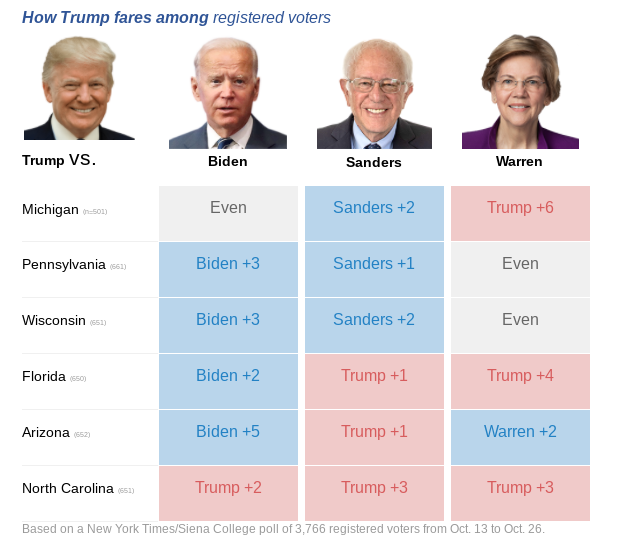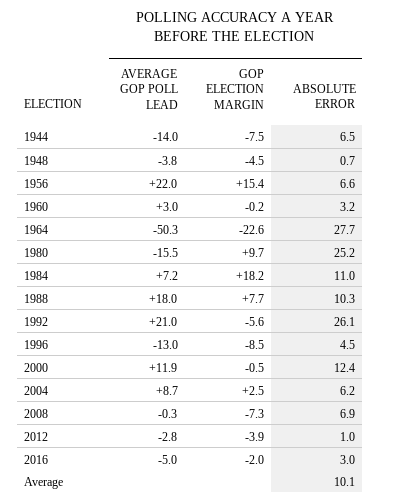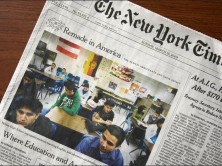
(Credit: Pixabay)
Much has been made of the recent New York Times/Siena poll of battleground states. The headline suggests its major finding: “One year from election, Trump trails Biden but Leads Warren in Battlegrounds.”
But a close analysis of the results suggests the author has engaged in what I would call analytical overkill. A more reasonable conclusion is that the election (even if held today) is really too close to call – regardless of whether Biden, Warren or Sanders is the nominee.
The graphic (below) from that Times article suggests that Joe Biden, but not Elizabeth Warren, could beat Trump (if the election were held today).

If Biden were able to win all the states that Hillary Clinton did, and also win in Pennsylvania, Wisconsin, Florida, and Arizona (all states where the poll shows Biden leading Trump), he would get 302 electoral votes – 32 more than needed to win the presidency.
The figures are not all that devastating for Warren, however. Were she to pick up Arizona (where the poll has her leading Trump), and eke out victories in Pennsylvania and Wisconsin (where the poll shows she is tied with Trump), she would also win the presidency – but with just 273 electoral votes.
Sanders, too, would win the presidency, if he won all the states Clinton did and picked up the states where the poll shows he is leading Trump. But the article focused only on the electoral strength of Warren vs. Biden, perhaps because Warren is polling ahead of Sanders in national primary polls, and/or because many now see Warren as the emerging frontrunner.
One could argue that in a general election poll a year away from the election, Biden should perform better. As vice president for eight years, he is better known to the electorate. Warren is still largely unknown to the vast majority of voters, who probably won’t really begin to focus on the presidential candidates until sometime after next summer.
Still, the numbers from this poll have apparently reinforced a collective frisson among establishment Democrats, who are now terrified that Biden’s lackluster performance on the campaign trail (especially in the last debate), and his slippage in the national primary polls, and also in Iowa, could mean Warren ends up the nominee and then goes on to lose to Trump in November.
Should We Take the NYT/Siena Poll Results Seriously?
According to FiveThirtyEight, not “no” but “$#!% No!”
That quotation was not in reference specifically to the NYT/Siena poll, but more generally to all general election polls a year out.
I identify at least three reasons to treat the NYT/Siena poll with caution.
1. The poll numbers showing differences in candidate support are all within the several polls’ margins of error. The sample size for each state is small. And for each state except Michigan, the margin of error is plus or minus 4.4 percentage points. For Michigan it’s 5.1. The lead that any candidate has over another has to be almost two times greater than the margin of error to be statistically significant – or about 8 to 9 percentage points. All differences between candidates reported by the poll are within four points.
All we can really conclude is that as of today, the election results would probably be very close, whether Trump’s opponent were Warren, Biden or Sanders.
2. This is just one poll. We shouldn’t rely very much on the results of any one poll. For example, over the same recent period of time (10/27-10/30), an ABC/Washington Post poll and an NBC/Wall Street Journal poll reported significantly different results in hypothetical matchups for the national general election. ABC/WP showed Biden and Warren beating Trump by 17 and 15 points, respectively. NBC/WSJ reported Biden and Warren beating Trump by just 9 and 8 points, respectively. Such wide divergences is why Real Clear Politics and other similar sites take the average of polls. But so far, there are no other polls specifically in those six battleground states to provide a state-by-state comparison with the NYT/Siena poll results. Ideally, we would have the results of other quality polls to measure support in the same states.
3. The election is still a year away. This is the most obvious, but still the most important, reason to be cautious about the poll’s results. How predictive are general election polls taken a year out from the election? FiveThirtyEight analyzed that question in 2015 and again this past June.

As the table shows, FiveThirtyEight found that the general election polls conducted a year out from the election were on average about ten points off the mark. In the last two election cycles, the polls a year out were actually pretty close to the final result – just off by three points in 2016 and one point in 2012. But in the previous two election cycles, the polls were off by more than six points, and in 2000, they were wrong by over 12 points. We don’t know what will happen in 2020. And we have no comparable data for these six battleground states to know how well polls a year out from the election correlated with the actual election results.
So, what does the NYT/Siena poll tell us? Mostly: The 2020 election will probably be close in the battleground states. That expectation, of course, is why those states are classified as battlegrounds in the first place.
Despite the careful analysis, the percentages are so close and the sample sizes so small, we really cannot conclude much about which of the three Democratic candidates would be likely to do better against Trump if the election were held today – much less a year from now.
The conclusion should not be that Biden does better than Warren against Trump, or even that Biden would win against Trump.
The reasonable conclusion is that in these battleground states, the election is simply too close to call.






